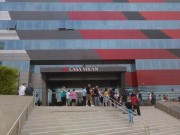Multi-club ownership in football – defined as an individual or private company owning shares in two or more clubs – has become an increasingly frequent phenomenon over the last ten years in particular. However, the practice of a larger corporation acquiring or merging with a smaller company is very common in the free market economy in which synergy plays a big role in companies’ growth.
Recently, Atlético Torque (Uruguay) have become part of the City Football Group, Atlético Madrid have invested in Atlético San Luis (Mexico) and AS Monaco have acquired Cercle Brugge KSV (Belgium).
In 1990, the portfolio of UK investment company ENIC included a majority stake of Tottenham Hotspur, as well as a majority shareholding in Czech club Slavia Praha and a minority share in Greece’s AEK Athens. Interestingly enough, after both clubs qualified for the UEFA Cup (1999/2000), the European Court of Arbitration for Sports ruled in favor of prohibiting any individual or company to have control over more than one club in the same European competition.
Although strict rules have been implemented at the national level to try to guarantee the integrity of domestic competitions, this is not the case in a global football landscape. With UEFA’s regulation proving to be an exception rather than the rule, many football clubs’ owners have been expanding internationally through acquisitions of subsidiary clubs, through which they establish a broader network that can encourage synergies from both a sporting (e.g. through improving scouting networks) and business perspective (e.g. through sharing expertise, cost efficiencies, mutualizing sponsorship efforts, etc.). In this case, the strongest opposition comes from fans if their club’s interest comes at the expenses of a broader corporate strategy.

In Italy, the Pozzo family provides an interesting example, according to KMPG Football Benchmark. The Italian family’s main quality over the years has been in identifying and acquiring young talent at Udinese Calcio, Granada CF – recently acquired by Chinese firm Desport – and Watford FC. As a result of this larger club network, the family minimized player acquisition costs while maximizing profit from higher transfer fees, as players were loaned between “sister clubs” and later sold at a premium. In addition, Granada CF and Watford have also profited by achieving promotion to La Liga and the Premier League respectively.
Large conglomerates owned by ambitious shareholders – such as Atlético Madrid and the City Football Group (CFG) – have also used a similar multi-ownership strategy but have had a different end goal, which has been to achieve a rapid acceleration in the growth of their brands. Through investments in emerging football markets, CFG now own Major League Soccer (MLS) franchise New York City FC, while Atlético and Fiorentina both partially own Indian Super League (ISL) franchises. These acquisitions provide unique exposure and prime access to key markets.

Foto PHC Images / Panoramic / Insidefoto
However, there are strings attached that can appear risky for established and prestigious European market leaders. Although this strategy certainly seems appealing for newcomers looking for high international profile and operational synergies, well-known teams always want to be associated with the best team possible. This is a very hard thing to predict in leagues in which salary cap regulations try to foster a higher degree of competition and fairness across all competing teams. For this reason, clubs like FC Barcelona are considering and implementing alternative strategies. The Catalan team, for instance, have confirmed their intention to create a women’s football franchise to join USA’s National Women’s Soccer League.
Establishing franchises in emerging football markets is clearly targeted to expand the club’s global awareness, while investments made in order to enhance an organization’s ability to recruit talent or increase efficiency in cost structure are still largely focused on traditional football nations. Atlético Torque (CFG), Atlético San Luis (Atlético Madrid) and – most recently – Club Brugge (AS Monaco) are examples of the latter approach, with owners trying to access to local talent by committing restricted capital for lower division clubs.
Lastly, the case of the Red Bull club network shows how a larger corporation with little previous association to football can leverage a multi-club strategy. Red Bull has in fact invested in the rebranding of several clubs in key markets, reflecting the company’s global business strategy. The most famous are RB Leipzig, Salzburg and New York Red Bulls, competing in Germany, Austria, and USA respectively. Furthermore, Red Bull is also present in Brazil, and had been in Ghana until 2014.

In a growing market like football, more and more clubs may decide to grow their brands, diversify their businesses and optimize their operations through multi-club ownership. The way it works right now is that a single team stays at the center of the vision of the multi-club structure. Nonetheless, in a changing environment, it wouldn’t be unrealistic to think of new precedents and strategies being established, perhaps even beginning next season.







































